 Facebook
Facebook
 X
X
 Instagram
Instagram
 TikTok
TikTok
 Youtube
Youtube
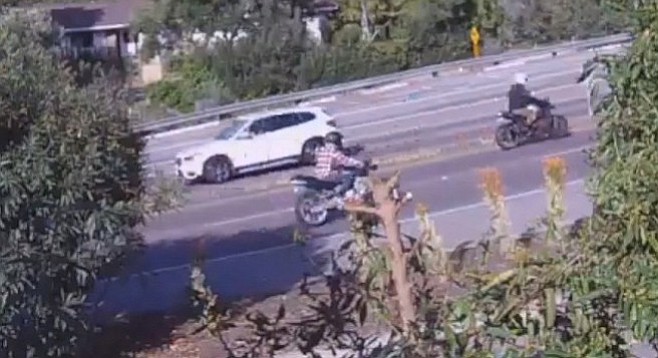
Residents living on Ardath Road and surrounding residential streets say they are at their wits’ end when it comes to noise produced by vehicles traveling in and out of La Jolla via La Jolla Parkway. Drivers taking this route are either coming or going from Interstate 5 or State Route 52.
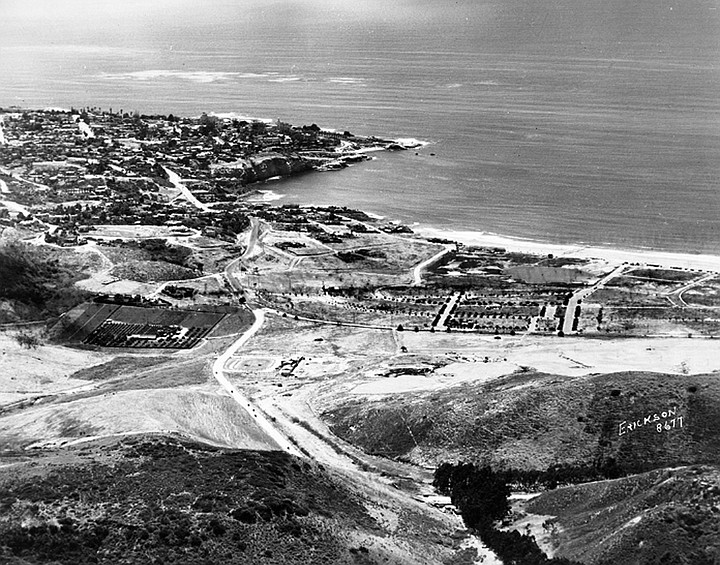
Residential Ardath Road, named so in 1935, is next to and parallel to the busy La Jolla Parkway. In 1968, when a four-lane connector road from Interstate 5 was constructed adjacent to the existing residential Ardath Road, it was also named Ardath Road. The latter was renamed La Jolla Parkway in 2002.
The renaming coincided with the widening of La Jolla Parkway. In 2003, a sound barrier wall was built along the residential Ardath Road — for some reason stopping after only two houses (200 feet).
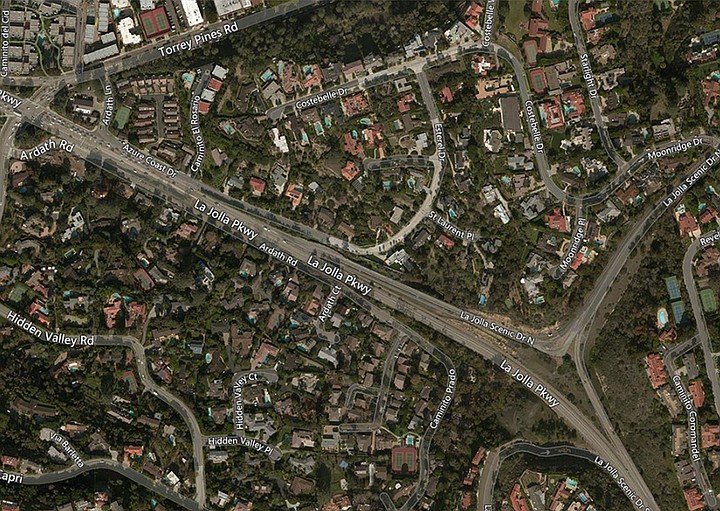
In November 2014, residents Richard Adams and Richard Haskal submitted a petition signed by 48 homeowners to then–La Jolla councilmember Sherri Lightner. They asked that the sound-barrier wall be extended and the aesthetics of the entrance to La Jolla, "San Diego's Jewel by the Pacific," be improved.
Rayan Hourani and Mark Pretorius are carrying the torch that Adams and Haskal lit four years ago.
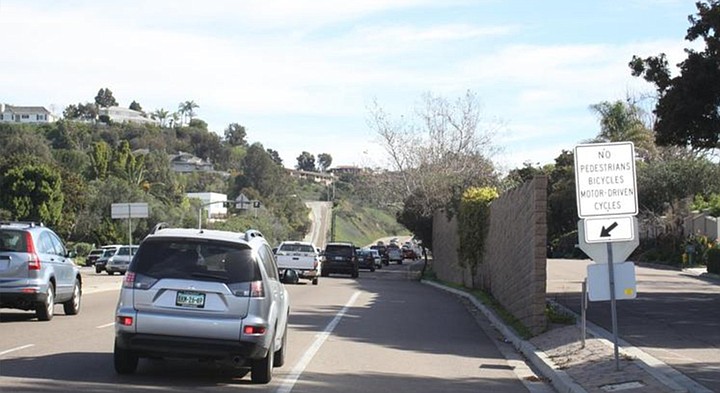
I asked Hourani what it's like living next to La Jolla Parkway. "I don't even call it a road. I call it a highway. It's technically not a freeway, but people drive like it is. It bisects a residential neighborhood without any sound-mitigating wall or safety barrier. This is a serious violation of local, state, and federal codes and regulations. The city knows that if anyone wanted to do a highway like that in 2017, it would never be approved with its current design."
On November 2, Hourani did his second presentation for the La Jolla planning association, which voted overwhelmingly in favor of the city doing something to help Hourani and his neighbors.
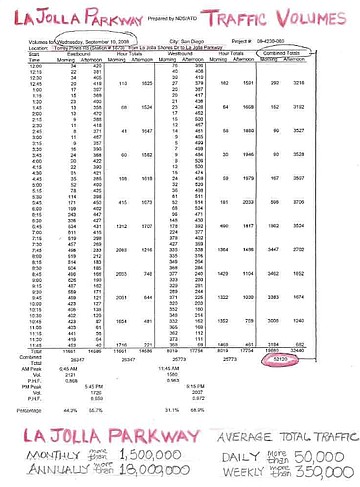
Hourani's presentation focused on the excessive noise and traffic, safety concerns, and hoped for mitigation measures — such as extending the sound-barrier wall started in 2003.
Hourani said more than 50,000 cars whiz past his neighborhood every day (more than 1.5 million a month). He showed me data collected in September 2008 that backs up those numbers. He cited a 2004 UCSD study that showed noise from vehicles traveling past his neighborhood averaged 75 decibels, with motorcycles reaching as high as 90 decibels.
The city's municipal code states noise should not exceed 40 to 50 decibels in a single-family residential neighborhood — the range dependent on the time of day.
Hourani presented a time-lapse video that shows the traffic in a typical 24-hour day. At one point in the video, at least 30 motorcycles can be seen and heard loudly speeding by at around 11:15 p.m. on a Wednesday.
"I sent a letter to the police department to ask that they at least enforce the [45 miles per hour] speed limit. Someone from the traffic division in the city said that more than 70 percent of motorists are driving over the speed limit, but it's not enforceable. I asked him to put that in writing and he refused. He said there isn't enough shoulder length to pull someone over. Why have a speed limit if you aren't going to enforce it?...
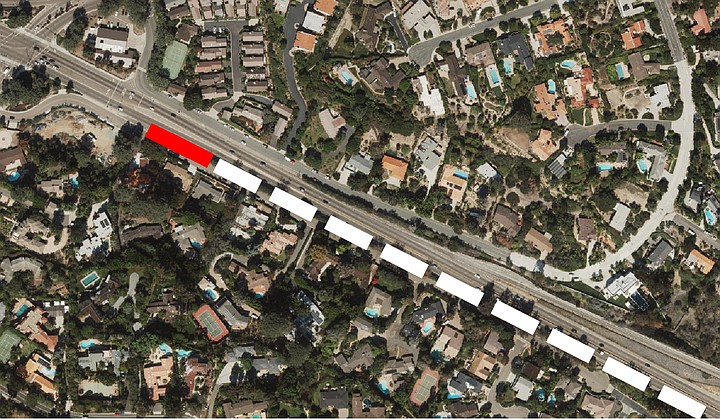
"We aren't asking the city to plant us a palm tree — this is about safety.” He pointed to an open area with no trees or bushes. "It's completely open. My daughter could just keep walking and get run over. If someone's dog or a cat went through there, they would be run over in a minute. A car could come through to us and hit a house, a pet, a child, an old person and kill them."
With no response from city hall, Hourani said he had a mutual acquaintance hand-deliver a packet into the mayor's hands so "they can't ever say they didn't know."
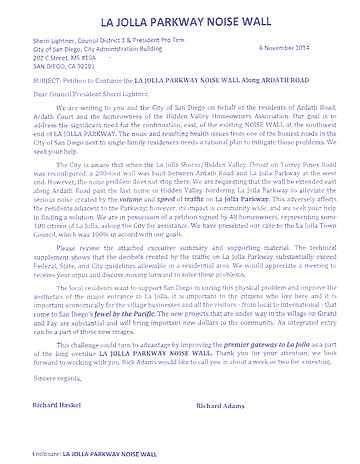
Helen (not her real name) moved into the neighborhood in the early 1970s. She said traffic back then was "just regular" and has "increased exponentially since then." She isn't inundated by the noise because her "important windows face the other direction." Though, she said, "At 2:00 a.m., when the bars close, I'm woken up by motorcycles."
Helen said that some of her neighbors are opposed to the sound wall because "they've gotten by and don't want any changes."
What she would really like to see is a redesign of the La Jolla Parkway entrance: "It's ugly. If you drive into Point Loma, they have a beautiful median. Going into [Ocean Beach], they have rocks and desert things. We definitely need landscaping in our entry way."
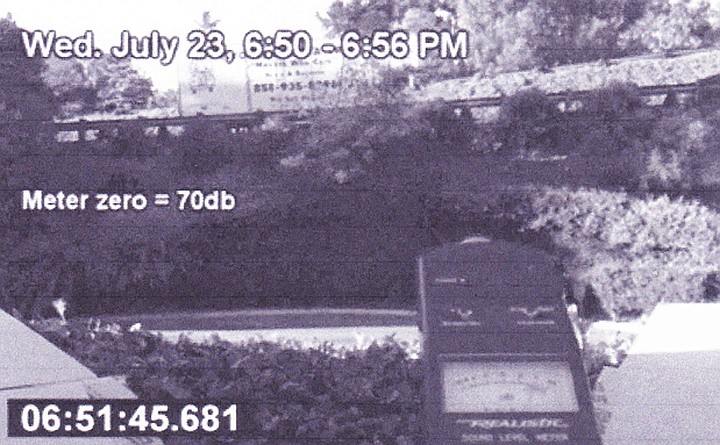
Helen recalls residents planting most of the trees where some want the wall extended. "One guy on Ardath Road planted first and everyone else kicked in and planted some too. The city planted those weird looking things in the gaps."
I asked the city why the wall never made it beyond 200 feet. Anthony Santacroce said environmental reports would have to be pulled to find out that answer. As of publication, Santacroce is working on that as well as getting a ballpark estimate for the cost to extend the wall by 1600 feet.
Scott Peters was the councilmember representing La Jolla when the wall was erected. I called the now–U.S. congressman to see if he could shed any light on why the wall wasn't extended past two homes. Peters had just gotten on a plane to DC, but I was promised someone would ask him and get back to me.
I asked the police department how many speeding tickets had been issued in the past 12 months on La Jolla Parkway. Instead of answering the question, they said to file a public records act request.
I asked the mayor's office for comment about their protocol when it comes to packets like the one Hourani had delivered to Faulconer. As of publication, both Hourani and I are awaiting a response.
According to the city's general plan, Hourani and his neighbors are due some sort of help to ensure interior noise levels don't exceed 45 decibels. The plan's noise section points to four basic methods to reduce noise from traffic. Two seem applicable to Hourani's situation.
One is to interrupt the sound by extending the barrier wall. The other is to reduce the sound at its source: since high speeds can increase noise tires make on pavement, enforcing speed limits would be part of the solution. Using low-noise pavement would be the other.
In 2016, low-noise pavement was reportedlyused for connector ramps to and from La Jolla Parkway. Unable to find anything in city documents, I asked Helen if she recalled hearing that the city used low-noise pavement on La Jolla Parkway. "I doubt it," Helen said.


Residents living on Ardath Road and surrounding residential streets say they are at their wits’ end when it comes to noise produced by vehicles traveling in and out of La Jolla via La Jolla Parkway. Drivers taking this route are either coming or going from Interstate 5 or State Route 52.

Residential Ardath Road, named so in 1935, is next to and parallel to the busy La Jolla Parkway. In 1968, when a four-lane connector road from Interstate 5 was constructed adjacent to the existing residential Ardath Road, it was also named Ardath Road. The latter was renamed La Jolla Parkway in 2002.
The renaming coincided with the widening of La Jolla Parkway. In 2003, a sound barrier wall was built along the residential Ardath Road — for some reason stopping after only two houses (200 feet).

In November 2014, residents Richard Adams and Richard Haskal submitted a petition signed by 48 homeowners to then–La Jolla councilmember Sherri Lightner. They asked that the sound-barrier wall be extended and the aesthetics of the entrance to La Jolla, "San Diego's Jewel by the Pacific," be improved.
Rayan Hourani and Mark Pretorius are carrying the torch that Adams and Haskal lit four years ago.

I asked Hourani what it's like living next to La Jolla Parkway. "I don't even call it a road. I call it a highway. It's technically not a freeway, but people drive like it is. It bisects a residential neighborhood without any sound-mitigating wall or safety barrier. This is a serious violation of local, state, and federal codes and regulations. The city knows that if anyone wanted to do a highway like that in 2017, it would never be approved with its current design."
On November 2, Hourani did his second presentation for the La Jolla planning association, which voted overwhelmingly in favor of the city doing something to help Hourani and his neighbors.

Hourani's presentation focused on the excessive noise and traffic, safety concerns, and hoped for mitigation measures — such as extending the sound-barrier wall started in 2003.
Hourani said more than 50,000 cars whiz past his neighborhood every day (more than 1.5 million a month). He showed me data collected in September 2008 that backs up those numbers. He cited a 2004 UCSD study that showed noise from vehicles traveling past his neighborhood averaged 75 decibels, with motorcycles reaching as high as 90 decibels.
The city's municipal code states noise should not exceed 40 to 50 decibels in a single-family residential neighborhood — the range dependent on the time of day.
Hourani presented a time-lapse video that shows the traffic in a typical 24-hour day. At one point in the video, at least 30 motorcycles can be seen and heard loudly speeding by at around 11:15 p.m. on a Wednesday.
"I sent a letter to the police department to ask that they at least enforce the [45 miles per hour] speed limit. Someone from the traffic division in the city said that more than 70 percent of motorists are driving over the speed limit, but it's not enforceable. I asked him to put that in writing and he refused. He said there isn't enough shoulder length to pull someone over. Why have a speed limit if you aren't going to enforce it?...

"We aren't asking the city to plant us a palm tree — this is about safety.” He pointed to an open area with no trees or bushes. "It's completely open. My daughter could just keep walking and get run over. If someone's dog or a cat went through there, they would be run over in a minute. A car could come through to us and hit a house, a pet, a child, an old person and kill them."
With no response from city hall, Hourani said he had a mutual acquaintance hand-deliver a packet into the mayor's hands so "they can't ever say they didn't know."

Helen (not her real name) moved into the neighborhood in the early 1970s. She said traffic back then was "just regular" and has "increased exponentially since then." She isn't inundated by the noise because her "important windows face the other direction." Though, she said, "At 2:00 a.m., when the bars close, I'm woken up by motorcycles."
Helen said that some of her neighbors are opposed to the sound wall because "they've gotten by and don't want any changes."
What she would really like to see is a redesign of the La Jolla Parkway entrance: "It's ugly. If you drive into Point Loma, they have a beautiful median. Going into [Ocean Beach], they have rocks and desert things. We definitely need landscaping in our entry way."

Helen recalls residents planting most of the trees where some want the wall extended. "One guy on Ardath Road planted first and everyone else kicked in and planted some too. The city planted those weird looking things in the gaps."
I asked the city why the wall never made it beyond 200 feet. Anthony Santacroce said environmental reports would have to be pulled to find out that answer. As of publication, Santacroce is working on that as well as getting a ballpark estimate for the cost to extend the wall by 1600 feet.
Scott Peters was the councilmember representing La Jolla when the wall was erected. I called the now–U.S. congressman to see if he could shed any light on why the wall wasn't extended past two homes. Peters had just gotten on a plane to DC, but I was promised someone would ask him and get back to me.
I asked the police department how many speeding tickets had been issued in the past 12 months on La Jolla Parkway. Instead of answering the question, they said to file a public records act request.
I asked the mayor's office for comment about their protocol when it comes to packets like the one Hourani had delivered to Faulconer. As of publication, both Hourani and I are awaiting a response.
According to the city's general plan, Hourani and his neighbors are due some sort of help to ensure interior noise levels don't exceed 45 decibels. The plan's noise section points to four basic methods to reduce noise from traffic. Two seem applicable to Hourani's situation.
One is to interrupt the sound by extending the barrier wall. The other is to reduce the sound at its source: since high speeds can increase noise tires make on pavement, enforcing speed limits would be part of the solution. Using low-noise pavement would be the other.
In 2016, low-noise pavement was reportedlyused for connector ramps to and from La Jolla Parkway. Unable to find anything in city documents, I asked Helen if she recalled hearing that the city used low-noise pavement on La Jolla Parkway. "I doubt it," Helen said.
Comments